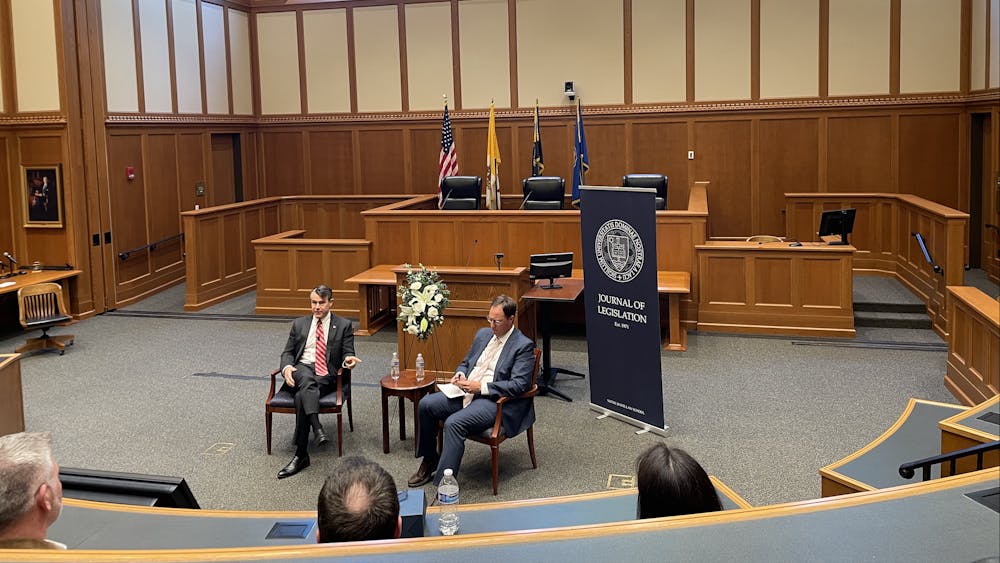On Saturday, a day-long conference convened in the McKenna Conference Center to address the role of pornography in modern society, titled "Pervasive Porn: Exploring the Personal and Social Costs of Pornography."
The conference is sponsored by Students for Child-Oriented Policy, the Tocqueville Program for Inquiry Into Religion and American Public Life, The "Irish Rover," "Ethika Politika," Sycamore Trust, Love and Fidelity Network, St. Edward’s Hall, Zahm House, Morrissey Manor, Stanford Hall, Fisher Hall and the Center for Ethics and Culture.
According to the Tocqueville Program's website, this conference "seeks to provide sound scholarship along with personal testimony and therapeutic experience" in order for members of the community to better understand the effects pornography has in society. The conference also aims to analyze the "means of addressing the porn problem with a specific regard for the well-being of the youngest and most vulnerable among us."
The conference included four panels on various issues with pornography, including addiction and psychology, the negative effects on pornography's participants, the theological perspective on pornography and philosophical approaches to the human dignity: "Pornography Addiction, Industry, and Relationship," "Pornography, Women, and Children," "In Principle: Philosophy and the Law" and "Theological Perspectives on Pornography."
Panelists address pornography addiction
On Saturday morning as the first panel of the day-long conference, three professors addressed pornography addiction, the industry and relationships. The panelists included professor of psychology William Struthers from Wheaton College, associate professor of economics Kirk Doran from Notre Dame and associate professor of sociology Mark Regnerus from University of Texas at Austin.
Struthers began the discussion by acknowledging the psychological aspect of porn addiction.
“When you look at an MRI, porn makes the brain light up in the same places that a drug addict’s brain will light up when the stimulus is presented to them,” Struthers said.
Although pornography is rejected by the Diagnostic and Statistical Manual of Mental Disorders (DSM-5) as an addiction, Struthers said he believes this is likely to change in the future. According to Struthers, things are addictive by acting on the brains neurons, and pornography “hijacks” those circuits in the brain to produce a supernormal response.
Doran continued the panel's discussion by explaining the market structure of the pornography industry and possibilities of regulation. According to Doran, there are 40,000 internet pornography sites which comprises a multi-million dollar industry in which consumers have a plethora of options.
“We could stop the production of pornography right now, but it wouldn’t do anything because there is so much out there already,” Doran said.
Doran also discussed the validity of a study showing that rape rates went down in areas where internet was more accessible or where Penthouse Magazine was available. These were both high-profile studies claiming there is less rape when pornography is available.
“There are serious flaws in these studies, and they definitely do not prove that pornography decreases rape,” Doran said. “The Penthouse Magazine is available to people with P.O. boxes — but so is Discover Magazine.”
According to Doran, the best option for regulation is to deal with the internet services providers hosting this material.
Regnerus then explored how the use of pornography changes people’s perception of marriage from a sociological standpoint, elaborating on the findings of a survey titled, “The Relationships in America."
“The survey showed us that women use significantly less pornography and that people use less as they age, which we refer to as the Aging Effect,” Regnerus said. “But what is disconcerting is the change of attitudes towards marriage that we see correlated with pornography use.”
According to Regnerus, there is an inverse relationship between porn used last week and frequency of church attendance. Men who use porn are more likely to support cohabitation before marriage, casual sex, “open” marriages and gay marriage. Furthermore, men who use porn think more about leaving their spouse and are overall less happy with life, he said.
Regnerus describes these findings as a “marital train wreck” in which people’s attitudes about relationships and marriage are changing.
“It's hard to say whether porn use directly causes these attitudes, but it is clear that even if you don’t watch porn, it still affects you,” Regnerus said.
Pornography's effects on its actors, viewers
In the conference's second panel, titled “Pornography, Women and Children,” three speakers discussed the effects of pornography in three different contexts. Mary Anne Layden, director of the sexual trauma and psychopathology program at the University of Pennsylvania; Donna Hughes, a professor of gender and women’s studies at the University of Rhode Island; and Mary Leary, a law professor at the Catholic University of America all participated in the discussion.
After a brief introduction by Christine Caron Gebhardt, director of Notre Dame's Gender Relations Center (GRC), Layden began the panel discussion by speaking first on the psychological effects of pornography use.
“Sex is now seen as a product and the body is a commodity, ... If it is a product, you can sell it, and if you can sell it, you can steal it," Layden said.
As a psychotherapist, Layden said she has seen the psychological effects of pornography on its viewers. According to some of her own studies, the more pornography a man watched, the less jail time he thought was appropriate for rapists; this correlation was true for women as well. People who watched more porn were also found to think that behavior such as bestiality and sadomasochism were practiced more regularly than they actually are.
Next, Hughes spoke about abuse and violence of women during the making of pornography.
“There was something that the feminists said in the ‘70s, and that is that pornography actually happens to women," Hughes said. "When you see a film of someone who’s shot, they didn’t actually shoot that person. And when there’s fistfights, they’re not actually beating each other up. They’re able to do these things to make it look like something’s happening. But in pornography, what you are seeing is actually being done to that woman.”
She went on to read statements from women who had acted in porn films and described how they were tricked or coerced into doing acts that differed from what they had first agreed to. She also discussed how the violence prevalent in pornography is becoming more desirable in real life.
“They want girls with no taboos, meaning that they can do whatever they want. They’ve been conditioned to do everything," Hughes said.
Leary then continued the panel discussion by addressing pornography and child sexual abuse images as they pertain to the law and our language.
“Language communicates values and morals. You call something ‘child pornography,’ a seemingly innocuous term that creates the suggestion that it’s pornography with young-looking adults. It’s not. It’s a child sex abuse image," Leary said.
She also said such pornography has long-term effects on the victims, and the victimization doesn’t end. Leary said the young actors have to live knowing the images are still being viewed.
She ended by sharing the words of a victim who one of her colleagues represents: “Being sexually assaulted, it was kind of like looking up and seeing people in a window, and they’re looking, and you think ‘Oh thank God, they’re going to come and help me.’ But instead, they’re just being entertained.”
'This is a form, I think, of self-mutilation'
Professor of philosophy Christopher Tollefsen, from the University of South Carolina, and professor of law Gerard Bradley, from Notre Dame, reflected on the moral and legal implications of pornography in modern culture as part of the conference's third panel, "In Principle; Philosophy and the Law."
Tollefsen said pornography affects multiple dimensions of the human person, such as family well-being, health and the ability to explore and discern truth and freedom. Tollefsen said the presence of pornography on university campuses was ultimately destructive to the nature of academic institutions.
“The university is a home for free inquiry into the truth. But pornography diminishes our freedom and erodes our grasp of truths of sex, marriage, family, self, society, reality and time, numb,” Tollefsen said. "The widespread use of pornography on a university campus, especially at a Catholic university, should be a source of very great concern.”
Tollefsen said the emotions and sexual desires towards those who are not spouses that are produced by pornography are not only corruptive to human nature, but rather run contrary to the virtue of chastity. He said pornography principally aims to erode chastity, a virtue that implies unwillingness to commit infedility or seek gratification from someone other than one’s spouse.
“The aim of producers [of pornography] is obviously to eliminate ... that unwillingness. Chaste persons are of no use to producers to pornography,” Tollefsen said. "Those who use pornography, as intended, erode in themselves this disposition that’s essential for human life. This is a form, I think, of self-mutilation.”
According to Tollefsen, pornography distorts both our relationship to God and our understanding of the present and time in relation to gratification.
“One is passive in relationship to porn’s content," he said. "The exploratory forms of engagement that characterize our relationship to the real world are absent when we render ourselves merely eyes for taking up images.”
Bradley then elaborated on the social and legal consequences of pornography and said while pornography has indeed been a destructive force in public and private life, the widespread disproval of pornography from the general public has the potential to curb the effects of pornography and create a comprehensive legal and social response to it.
“I’m talking about a socially responsible ethic so that even someone who believes himself/herself to be immune to the allures and dangers of porn should support a campaign to stigmatize it because that will help other people,” Bradley said.
Bradley said in order to effectively combat pornography, there needs to be a collective response to porn that involves both strong social attitudes against pornographic consumption and a secondary legal response. Bradley said this secondary legal response should include legal measures against access to pornography on campuses and other public places and legal action against producers of pornography.
“We should use the law in some essential but secondary ways to create and maintain a social, cultural stigma on pornography,” Bradley said.
Though Bradley acknowledged the effects of pornography may vary by person and may not pose a threat to all, he said the dangers pornography poses to the population collectively still require a widespread condemnation of its usage and distribution.
“The burden of my remarks really is to instill in the American people a sense of social responsibility for porn. For too long it’s been a matter of pure consumerism,” Bradley said.













